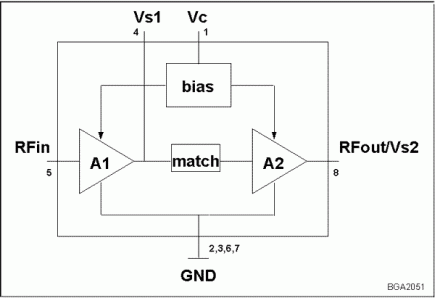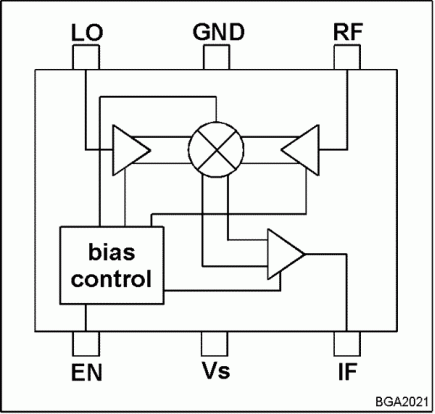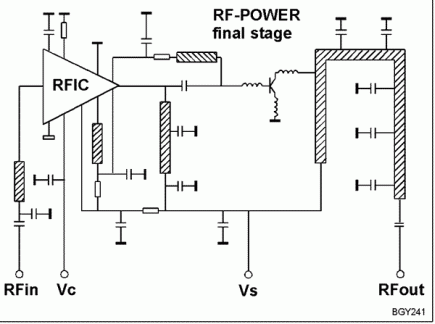|
|
|
|
|
1997-12-15
,
ESC-9740
Small scale integration enables mobile phones to be made smaller and lighter
Philips Semiconductors' Double Poly technology - enabling RF transistors used in mobile phones to be made in silicon rather than gallium arsenide (GaAs)- has been enhanced so that inductance loops, capacitors and resistors are now included on-chip to create MMICs (Monolithic Microwave Integrated Circuits). Double Poly, launched in February 1997, was a processing breakthrough in the production of silicon RF transistors with transition frequencies (fT ) of better than 23 GHz. Using these new MMICs, the external component count in a mobile phone's receiver front end circuit is reduced typically from thirty to around six. This reduction lowers the overall materials bill, the cost of manufacture and logistics, as well as the size and weight of the phone. Mobile phones will now be easier and quicker to design - and more reliable. In addition to their small signal use, these new MMICs can be used in the phone's RF power amplification stage. Double Poly technology has a further benefit in that it is optimised for 2.4 to 3.0 V operation; this reduces the phone's weight, without compromising standby and talk times, because the battery pack (usually the largest and heaviest item in a mobile phone design) can be made smaller and lighter using only two cells instead of three. "This breakthrough further confirms our leadership in mobile phone technology," explained Rein van der Bij, Philips Semiconductors' Strategic Marketing Manager for Discretes. "Drawing on our unique position as a leading supplier of both discretes and ICs, we are using our IC expertise to integrate passive components onto active discretes to create the first 'smart transistors'. This eliminates many of the time-consuming calculations that manufacturers need to do when designing with 'simple' transistors, and allows for the easy introduction of enhanced features. It also complements our expertise in GaAs and QUBiC BiCMOS processes, so that we can offer customers whichever is the most appropriate high frequency RF technology for their application. "These new MMICs can be used in systems with operating frequencies above 2.4 GHz, providing the best high-gain RF capability of any silicon-based process. This enables them to be used to create the next generation of mobile phones for every system used in the world today, such as GSM, DECT, and PHS (the Japanese Personal Handy phone System). In fact, this technology can be used to create advanced solutions for any area that needs a high gain in the region of 20 dB at 2 GHz and relatively low noise (less than 1.2 dB) at high frequencies. For example, Double Poly MMICs can be designed into pagers, set-top boxes, CATV (Cable TV) amplifiers, RF power modules for mobile phone base stations, radar detectors, RF toll road applications, etc." Despite increasing the complexity of the devices, the overall die size for the Double Poly MMICs remains minute. Thus, in many cases, Philips Semiconductors can keep the very small packaging that was used for the single transistors on their own. This, coupled with no additional process steps being required, helps to keep the cost down so that these new devices offer considerable cost advantages when compared to an equivalent circuit made with discrete components. One of the major benefits of Double Poly MMICs is the integration of temperature compensation bias circuitry; the devices give a linear response with very little spread over temperature changes from -20 to +85*C. The resulting MMIC has very stable and predictable performance. This is an enormous advantage to mobile phone designers: they can avoid the time and expense of testing rigorously the device's performance with temperature, and they no longer have to design compensation circuitry to cope with performance spread from temperature changes. In addition, with the new MMICs, there is no need to fine tune the phone during construction, which saves time and reduces manufacturing costs. Philips Semiconductors has chosen the small scale integration route by designing several small building blocks, rather than integrating several chips into one. There are several reasons for this. Designers will now find it easier to design and construct very small circuits because Philips Semiconductors has put its MMICs into the extremely small 'discretes packages' which are already familiar to them. The use of small building blocks minimises problems with parasitics and cross talk, and because of the dedicated function it limits the possibility of RF interference on the chip. The building block approach also offers the designer greater flexibility to tailor the optimum solution to suit each individual application. Philips Semiconductors has designed several devices using this new technology, which will be available in early 1998. These include the BGA2001/2/3 MMIC amplifiers, the BGA2051 MMIC power amplifier, the BGA2021 mixer MMIC and the BGY241 UHF amplifier module where it was possible to achieve high performance combined with very small size, because of the use of Double Poly MMICs and power stages.
Figure 1 BGA2001, BGA2002, and BGA2003 MMIC amplifiers (see figure 1) These amplifiers have an NPN Double Poly RF transistor combined with an integrated temperature compensation bias in a plastic 4-pin SOT343 package. They offer very high power gains (19 dB for the BGA2001 and 21 dB for the BGA2002/BGA2003) with very low noise figures of 1.5 dB and 1.9 dB respectively (for 2 GHz). BGA2001 and BGA2002 have a fixed bias current of 4 mA and 10 mA respectively (at 2.5 V supply), while the bias current of BGA2003 is adjustable up to 30 mA by means of a control pin. The latter means that the collector current can be switched from the bias control circuit, which requires a very low current, without disconnecting the transistor from the power supply. These products are easy-to-use general purpose RF amplifiers that combine the advantages of integration with the high performance of discrete transistors. They can be used for LNAs and mixers in wide-band applications such as analog and digital cellular telephones, as well as PHS and DECT cordless telephones, radar detectors, satellite television tuners, and high frequency oscillators. 
Figure 2 BGA2051 MMIC power amplifier (figure 2) This two stage power amplifier can deliver an output power of 400 mW at a supply voltage of 3.6 V, and the output can be controlled via a pulsed DC voltage to switch for Time Division Multiple Access (TDMA) applications. It is supplied in an 8-pin plastic surface mount package. This high gain (23 dB) amplifier is ideal for 1.88 to 1.92 GHz cordless telephones such as DECT, PHS and PWT (Personal Wireless Telephone). 
Figure 3 BGA2021 mixer MMIC (figure 3) This easy-to-use mixer is primarily intended for applications in the receiver side of wireless systems as it can handle a large frequency range from 0.5 to 2.5 GHz. It has an enable switch pin and offers high gain, low noise figure and high IP3 (third order intercept point). The internally balanced structure ensures excellent isolation. It is available in a 6-pin SOT 457 (SC74) surface mount package. 
Figure 4 BGY241 UHF amplifier module (figure 4) This is a three stage UHF amplifier with 35 dBm output power in a SOT482A leadless package, comprising one NPN silicon planar transistor die and one bipolar monolithic integrated circuit mounted on a metallised ceramic substrate, together with matching and bias circuitry. It is ideal for use in digital cellular radio systems with TDMA operation in the 880 to 915 MHz frequency range, such as GSM. see also Background Information E/DS-858/120 and E/DS-859/120. Philips Semiconductors, a division of Philips Electronics NV, headquartered in Eindhoven, The Netherlands, is the ninth largest semiconductor supplier in the world and the fourth largest supplier of discretes in the world. Philips Semiconductors' innovations in digital audio, video, and mobile technology position the company as a leader in the consumer, multimedia and wireless communications markets. Sales offices are located in all major markets around the world and are supported by systems labs. |
|||||||||||||||||||||||||||||||||||||||||||||||||||||||||||||||||
|
Copyright © 2000 Royal Philips Electronics All rights reserved. Terms and conditions. |
|